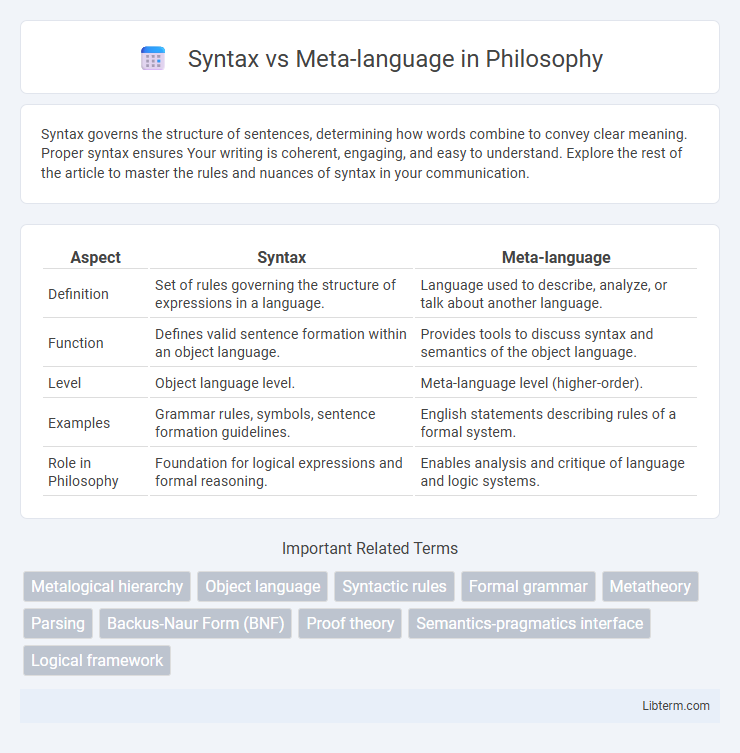Syntax governs the structure of sentences, determining how words combine to convey clear meaning. Proper syntax ensures Your writing is coherent, engaging, and easy to understand. Explore the rest of the article to master the rules and nuances of syntax in your communication.
Table of Comparison
| Aspect | Syntax | Meta-language |
|---|---|---|
| Definition | Set of rules governing the structure of expressions in a language. | Language used to describe, analyze, or talk about another language. |
| Function | Defines valid sentence formation within an object language. | Provides tools to discuss syntax and semantics of the object language. |
| Level | Object language level. | Meta-language level (higher-order). |
| Examples | Grammar rules, symbols, sentence formation guidelines. | English statements describing rules of a formal system. |
| Role in Philosophy | Foundation for logical expressions and formal reasoning. | Enables analysis and critique of language and logic systems. |
Introduction to Syntax and Meta-language
Syntax studies the rules and structures governing sentence formation in a language, focusing on how words combine to create meaningful expressions. Meta-language refers to the language used to describe, analyze, and discuss the properties and rules of the object language, often employing specialized terms and symbols. Understanding the distinction enables effective linguistic analysis and the development of formal grammars essential for computational linguistics and language theory.
Defining Syntax: Structure and Rules
Syntax defines the formal structure and rules governing the arrangement of symbols in a language, ensuring that expressions are well-formed and meaningful within that system. It specifies permissible sequences and hierarchical organization, such as sentence formation in natural languages or statement construction in programming languages. Meta-language, in contrast, is used to describe and analyze the syntax itself, providing terminology and frameworks to interpret syntactic rules.
What is Meta-language? A Linguistic Perspective
Meta-language refers to a language used to describe, analyze, or discuss another language (the object language) within linguistic theory. It provides the tools and vocabulary for defining syntax, semantics, and other structural aspects of object languages, enabling precise linguistic analysis and formalization. In contrast to syntax, which focuses on constructing correct sentences within a language, meta-language operates at a higher level by interpreting and explaining the rules and components of the object language itself.
Key Differences Between Syntax and Meta-language
Syntax defines the formal rules and structure governing the arrangement of symbols within a language, enabling the formation of valid sentences or expressions. Meta-language serves as the language used to describe, analyze, or discuss another language, often employing specific terminology to explain syntactic and semantic features. Key differences include that syntax operates within the object language itself, while meta-language functions externally to analyze or interpret the object language's structure and meaning.
The Role of Syntax in Language Formation
Syntax defines the structural rules governing the arrangement of words and phrases in sentences, enabling the formation of coherent and meaningful language. It provides a framework for combining lexical elements into complex expressions, facilitating communication and interpretation. Unlike meta-language, which describes or analyzes language, syntax operates within the language itself as the foundational system guiding sentence construction.
How Meta-language Describes Language Systems
Meta-language provides a framework to describe and analyze the structure and rules of a language system by using terms and concepts from outside the language itself. It enables linguists and computer scientists to define syntax, semantics, and phonology systematically, facilitating clear communication about language elements without ambiguity. By employing meta-language, complex language phenomena can be precisely categorized, enabling the creation of formal grammars and language models essential for natural language processing and programming language design.
Applications of Syntax in Computer Science
Syntax in computer science defines the formal rules governing the structure of programming languages, enabling precise interpretation and compilation of code. Applications of syntax include designing compilers and interpreters, which rely on syntax analysis to parse and translate source code into machine-executable instructions. Syntax also plays a crucial role in software development tools such as syntax highlighting, code completion, and static analysis, enhancing code readability and error detection.
Importance of Meta-language in Linguistic Analysis
Meta-language plays a crucial role in linguistic analysis by providing a structured framework to describe and analyze the syntax of natural languages. It allows linguists to create precise definitions, rules, and categories that clarify the structure and function of language elements. The use of meta-language enhances the ability to compare languages, develop grammatical theories, and improve computational language models.
Syntax vs Meta-language: Practical Examples
Syntax defines the formal rules and structure governing how symbols and statements are combined within a language, such as grammar in programming or natural languages. Meta-language is the language used to describe, analyze, or define the syntax, often seen in linguistic theory or programming language specification documents. For instance, Backus-Naur Form (BNF) is a meta-language used to express the syntax rules of programming languages like Python or JavaScript.
Conclusion: Integrating Syntax and Meta-language in Language Study
Integrating syntax and meta-language in language study enhances comprehensive linguistic analysis by combining structural rules with descriptive frameworks. Syntax provides the foundational rules for sentence formation, while meta-language offers the tools to discuss and evaluate those rules effectively. This synthesis enables deeper understanding and more precise communication about language phenomena.
Syntax Infographic

 libterm.com
libterm.com